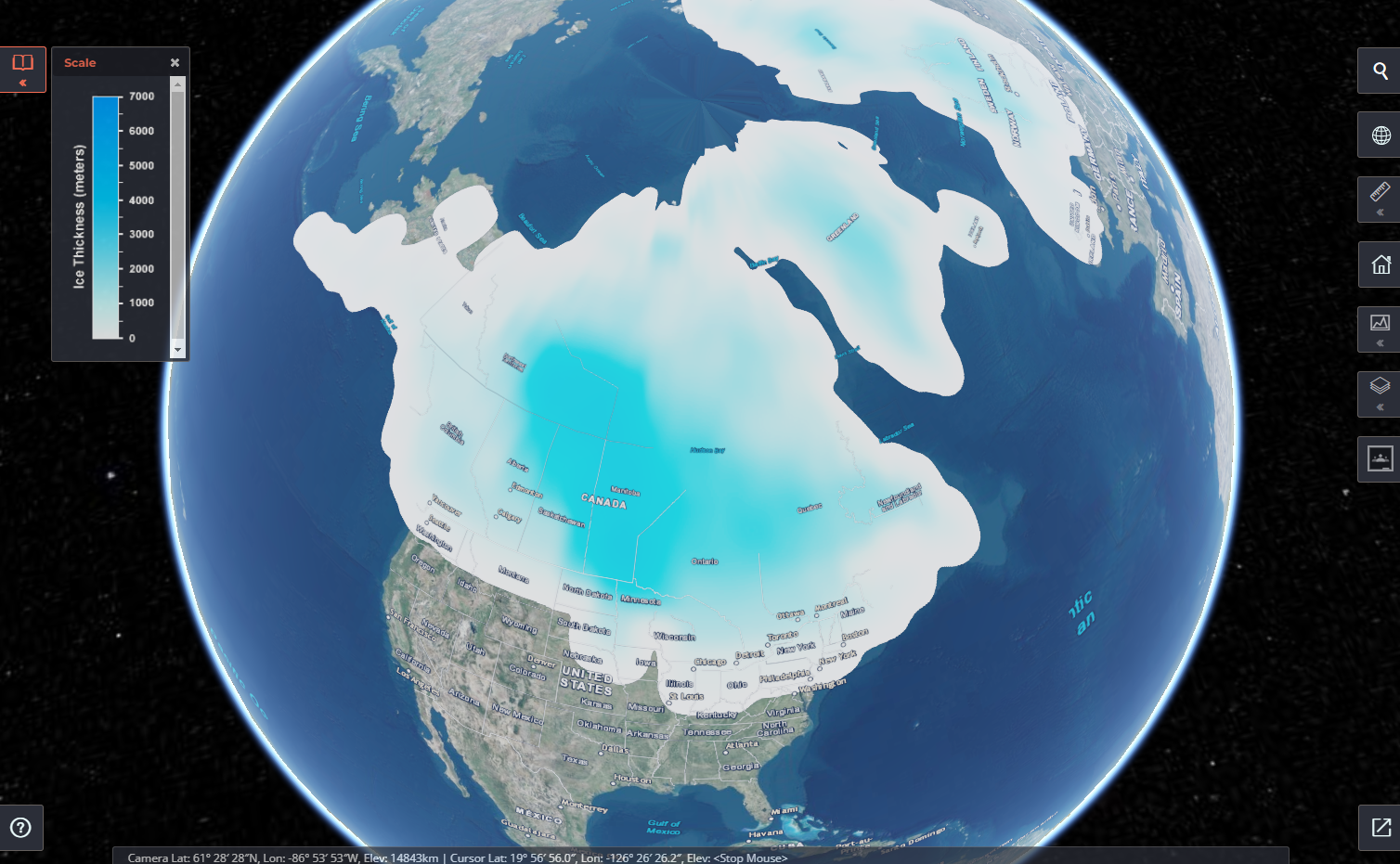Investigating the Cryosphere: Analyzing Ice Cover - Past and Present
Objective: This activity aims to analyze how ice cover has changed in the past and examine current changes in the world's ice cover.
Materials Required: Everything that you need for this exercise is included in the on-screen components.
Time Required: approximately 1 ½ hour
The Earth is a complex planet that consists of many interrelated natural systems. One of those dynamic natural systems, the cryosphere, includes all of the Earth's frozen water, including the polar ice caps, glaciers, and snow. The cryosphere is of particular importance to scientists because global changes to the Earth's ice cover can act as an important indicator of global climate change. In this Unit Activity, you will investigate the role of ice cover in the Earth's last ice age. You will also examine how ice cover is currently changing.
Part A: Ice Cover During North America's Last Ice Age
Several times in the last few million years, the global climate has experienced an average temperature drop of approximately 5° C. Each of these temperature drops was accompanied by significant parts of the Earth being covered by vast ice sheets, in other words, a dramatic increase in the size of the cryosphere. These temperature drops accompanied by increases in continental ice cover are known as ice ages.
The last ice age on Earth, known as the Wisconsin Ice Age, started about 114,000 years ago and ended approximately 10,000 years ago. The maximum extent of ice cover on the North American continent during the most recent ice age occurred approximately 18,000 years ago.
- Click here to see the extent of the ice sheets covering North America 18,000 years ago.

-
- Which North American country was completely covered by ice 18,000 years ago?
Zoom in on the continental United States and use the measuring tools to estimate what area of the continental United States was covered by ice at this time.
-
- How much (in km2) of the continental United States was covered by ice 18,000 years ago?
-
- The surface of the continental United States is approximately 8.08 × 106 km2. Use your answer to the previous question to determine what percentage of the surface area of the continental U.S. was covered by ice 18,000 years ago.
You will now view the extent of ice cover in North America in 1,000-year increments from 17,000 years ago to 10,000 years ago. Click on each year to see the extent of ice cover in North America:
- 17,000 years ago
- 16,000 years ago
- 15,000 years ago
- 14,000 years ago
- 13,000 years ago
- 12,000 years ago
- 11,000 years ago
- 10,000 years ago
-
- When did the first part of Canada begin to emerge from the ice cover?
-
- When did the Great Lakes first start to be uncovered from their ice cover?
-
- When were Alaska and the continental U.S. again linked by an ice-free land corridor?
-
- When were the Great Lakes completely free of ice?
Part B: Ice Cover Today
- Click here to see a map of ice cover in the world today.
-
-
- Which part of the northern hemisphere has the thickest ice cover?
-
- What is the estimated ice thickness (in meters) here?
-
-
-
- Which part of the southern hemisphere has the thickest ice cover?
-
- What is the estimated ice thickness (in meters) here?
-
Many scientists are greatly concerned about the present state of the cryosphere. This is because of a global trend towards decreasing snow and ice cover as a result of climate change. One area of particular concern in the Himalayas in Asia. Glaciers in the Himalayas act as the source for many of the major rivers in Asia. Scientists are concerned that drastic social problems may arise as a result of water shortages in Asia in the future. A brief examination of the Gangotri Glacier, the largest glacier in the central Himalayas, reveals why scientists are concerned.
- Click here to see the Gangotri Glacier.
- Click here to see how ice has retreated in the Gangotri Glacier since 1780.
Use the distance measuring tool to answer the next question.
-
- How far did the glacial ice retreat between:
-
- 1780 and 1935?
-
- 1935 and 1971?
-
- 1971 and 2001?
-
- What is happening to the rate of glacial retreat in the Gangotri Glacier?
- How far did the glacial ice retreat between:
